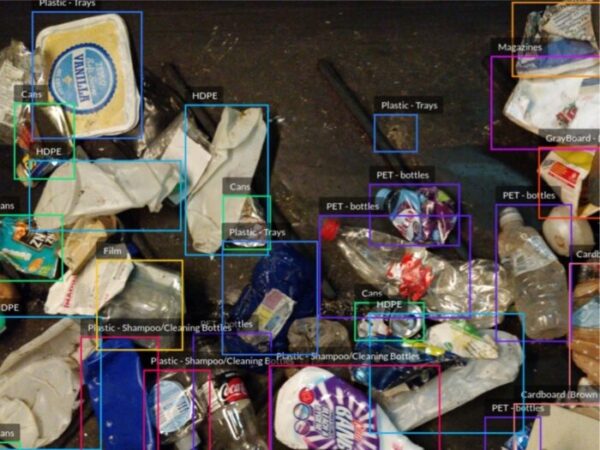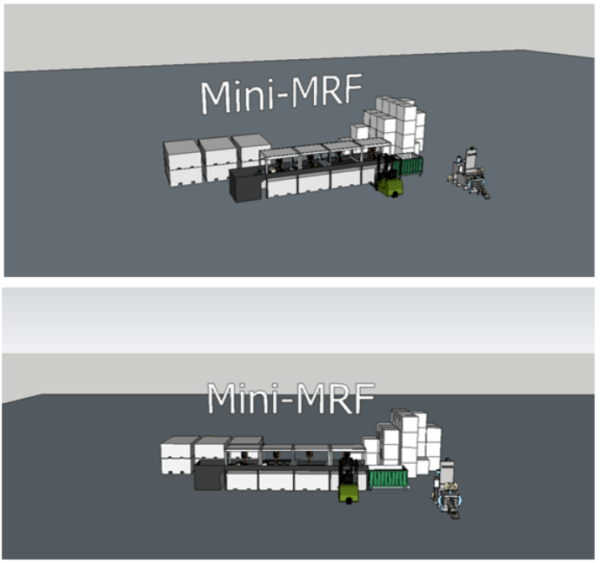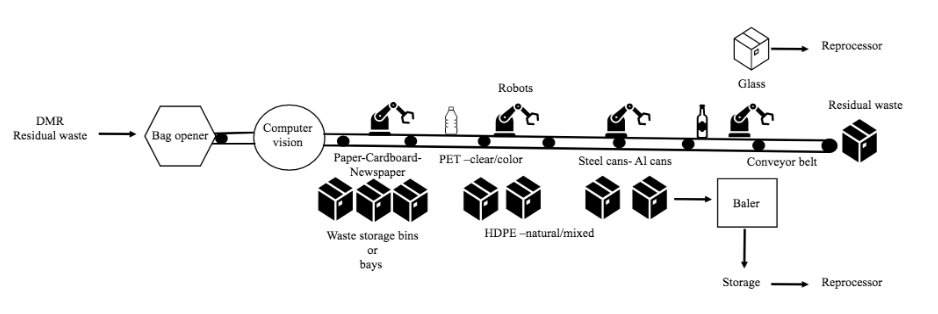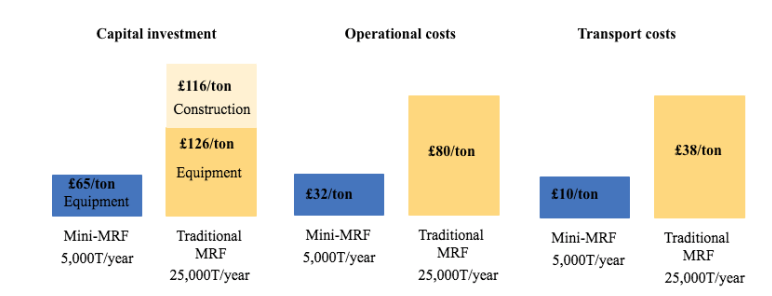This research explores the disruption of centralised waste facilities to accommodate a decentralised model, known as the mini-MRF, that is capable of extracting more value out of waste streams. Centralised facilities possess a hoax of challenges, be it their complex infrastructure or high capital and operational costs. With that said, existing systems characterise an unsustainable solution for long-term waste management, and a worthy solution to these issues is crucial for effective management of our planet’s resources.
Advancements in the technological landscape in recent years has revealed the opportunity to integrate computer vision and robotics into existing waste systems. A more robust configuration, modelled as the mini-MRF, will unlock the full potential of the 21st century waste sorting infrastructure.
Innovation Through 21st Century Technology

Identification of materials using computer vision
The problematic components of existing MRFs includes their complex sorting methods, capital and operational costs, weak adaptability, and low quality/purity standards.
For instance, with respect to their complex sorting methods, there are large varieties of materials entering the MRFs that need to be sorted into distinct fractions. These rely on numerous components to sort each type of waste, such as eddy currents for non-ferrous materials or ballistic seperators for paper – all of which are incredibly costly to maintain. Additionally, these mechanics are subject to failures and blockages that require greater facility downtime – forfeiting the efficiency of sorting processes and increasing the risks associated with operational over-capacity. As of now, these complex systems are incapable of recovering all materials that reach MRFs despite machinery reaching its maturity peak. It is recorded that out of the 2 trillion tonnes of waste that is produced globally each year, only a mere 8% is recycled. In light of this, an innovative solution is paramount to our transition towards the circular economy.
The mini-MRF Model

A visual representation of the mini-MRF model
The mini-MRF hopes to achieve three diverse sorting abilities:
- Identifying contaminated objects from source segregated streams, such as paper and cardboard, before being sold to a processor.
- Identifying targeted recyclables from residual waste by running positive picking, ultimately reducing the weight of residual waste to be disposed by the operator.
- Identifying targeted recyclables from DMR (dry mixed recyclables), leaving behind a residual waste stream.

High-level process flow sheet for the mini-MRF
Above all, the main purpose of the mini-MRF is to facilitate decentralisation of waste sorting ability, ideally in high-quality waste generating locations such as airports, shopping centres and residential areas. Decentralisation of waste sorting also aims to reduce collection and transportation costs, reduce carbon emissions from collection vehicles, increase rates of recycling, and increase value of these sorted materials.
Cost Analysis and Results
The investment opportunity of the mini-MRF model was assessed by creating a ten–year cash flow projection.
The cash flow projection assesses the profitability of the system by determining the NPV, IRR, and ROI of the project based on a 12% discount rate as well as having a global overview on the cash flow.
From a financial viewpoint, the proposed mini-MRF model has a five year payback period, a NPV of £1,308,911 an IRR of 80% over 10 years and a ROI of 76% based on the assumptions found. Net cash flow for years 1-5 was found to be £256,444/year and £338,844/year for years 6-10.
Overall, this configuration is proven to be a profitable and worthy investment to the long-term health of the waste management industry.
The mini-MRF versus the Traditional MRF

Graphical cost comparison between the mini-MRF model (blue) and traditional MRF model (yellow)
It is clear that the costs associated with running a mini-MRF are significantly lower than the costs of running a traditional MRF.
The most considerable costs incurred to traditional MRFs lies in construction expenses, specifically related to the surface areas required to sort these vast amounts of material, in addition to the various sorting mechanics required to handle co-mingled waste. Other factors include costs of extensive manual labour and costs of transportation for waste collection vehicles – compounded with additional maintenance and parking costs associated.
From an operational standpoint, traditional MRFs are disadvantaged by the considerable costs associated with manual labour, which is expected to be around 36% of the total operational budget for only 30 employees. In comparison, the mini-MRF model would typically require a minimum of 2-4 employees for higher capacity operations – therefore yielding significant savings. Furthermore, by enabling decentralisation of waste sorting facilities, the mini-MRF also ensures that the high costs associated with traditional MRFs – of approximately £38/tonne from transportation, vehicle, and parking costs – are significantly reduced.
In Conclusion
Technological advancements have enabled a worthy solution for the management of co-mingled waste in the form of a decentralised, mini-MRF. The profitability of this configuration was assessed through a ten-year cash flow projection, showcasing it to be a highly profitable investment for the effective management of waste flow.
In addition to this, the mini-MRF model is presented as a novel solution to the challenges currently faced in traditional MRFs. From an environmental and economic standpoint, this new model has successfully improved co-mingled waste management, outperforming centralised MRFs in all aspects of operation. As the population and global waste generation continue to rise at an exponential pace, the ability to handle such vast amounts of waste is declining. It is therefore necessary for the waste management industry to retrofit existing systems and introduce more robust infrastructures to accommodate for a more sustainable future.